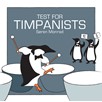Item details
-
Description +
-
Duration: 4 min.
Etude 111 covers different musical and technical aspects of high level timpani playing. It is divided into three parts:
Part One is focusing on relaxed and easy movements of both hands and arms in order to train virtuoso independent playing. Depending on the technical skills, the player should try to play the left kettle drum with the left and the right with the right hand if possible. If sixteenth notes can not be articulated precisely with one hand it is recommended to play hand by hand. The use of wooden sticks creates a pizzicato-like sound.
In Part Two the rhythmic structures of the beginning are transferred from two to four instruments, which widely extends the spectrum of intervals. This allows plenty of musical lines, particularly through the use of pedals.
Flannel mallets both improve the quality of sound and the exact articulation. “Sticking “ can be chosen individually.
Part Three puts emphasis on a differentiated playing of the roll. The precise beginning or ending of a roll, with accent or without, the musical development of crescendo and decrescendo, the legato playing over several timpani and/or the speed of tremolo are some of the basics for a high level interpretation.
For this part I recommend medium-hard, medium-big felt mallets. Tones different from F, Db, Bb, F at the beginning have to be played by pedaling.
Klaus Treßelt
-
-
Instrumentation +
-
Timpani
-
-
About the composer +
-
For more information please contact the Publishing House.
-
-
Reviews +
-
To come.
-
-
Credits +
-
Front Cover graphics and layout: Kirstine Kørner Jensen
Engraving: Johan Svitzer
Printed in Copenhagen, Denmark
www.editionsvitzer.com
-







